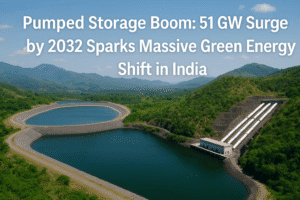Pumped Storage Boom: 51 GW Surge by 2032 Sparks Massive Green Energy Shift in India
India is embarking on a transformative energy shift, targeting a tenfold surge in pumped storage hydropower (PSH) capacity—from under 5 GW to 51 GW by 2032—to stabilize its grid amid rising solar and wind integration. Three major firms, Greenko (13.2 GW), Adani Green (11.4 GW), and JSW Energy (7.7 GW), are spearheading nearly 65% of this expansion, leveraging Andhra Pradesh and Maharashtra, which hold 40% of India’s 176 GW PSH potential.
These projects use paired reservoirs to store and generate energy, acting as “water batteries” to balance peak demand. While PSH faces hurdles like 5-year construction timelines and environmental approvals, its scalability offers an edge over battery storage, which relies on volatile Chinese supply chains. India’s dual focus on PSH and battery systems underscores a pragmatic strategy to ensure energy security and grid reliability. With 10 GW under construction and 3 GW set for 2024 completion, this push aligns with India’s goal of 500 GW renewables by 2030, positioning PSH as a linchpin for a sustainable, resilient power future.

Pumped Storage Boom: 51 GW Surge by 2032 Sparks Massive Green Energy Shift in India
India is accelerating its transition to renewable energy with a bold plan to expand its pumped storage hydropower capacity from under 5 GW today to 51 GW by 2032—a tenfold increase. This strategic move aims to stabilize the grid as the nation integrates more variable solar and wind power. Three major players—Greenko, Adani Green, and JSW Energy—are poised to deliver nearly two-thirds of this capacity, signaling a transformative shift in India’s energy storage landscape.
Why Pumped Storage Matters
Pumped storage hydropower (PSH) acts as a giant “water battery.” During periods of low electricity demand, excess solar energy pumps water from a lower reservoir to an upper reservoir. When demand spikes, water is released downhill through turbines, generating electricity. This technology is critical for balancing the grid, especially during non-solar hours, and complements battery storage systems (BESS). While BESS offers rapid deployment, PSH dominates global energy storage (90% of capacity) due to its scalability and longer discharge times.
The Key Players and Their Projects
- Greenko Group: Leading with 25% of the pipeline (13.2 GW), Hyderabad-based Greenko is set to commission its first 1,680 MW project in Pinnapuram, Andhra Pradesh, by September 2024. The company, traditionally focused on run-of-river hydropower, now aims to become a PSH heavyweight.
- Adani Green: With 11.4 GW (22%) in development, Adani’s first 500 MW project near Chitravathi Dam (Andhra Pradesh) is slated for 2027. Executives highlight PSH’s attractive internal returns (IRR), surpassing standard solar/wind projects by ~2%.
- JSW Energy: Contributing 15% (7.7 GW), JSW is expanding its renewable portfolio, leveraging PSH’s profitability amid rising peak power demand.
Geographic Hotspots: Andhra Pradesh and Maharashtra
India’s PSH potential totals 176 GW, with 40% concentrated in Andhra Pradesh (70 GW) and Maharashtra. By 2032:
- Andhra Pradesh will host 16 GW, driven by its hilly terrain and existing hydropower infrastructure.
- Maharashtra follows with 13 GW, capitalizing on its Western Ghats topography.
Other states like Uttarakhand (THDC’s 1,000 MW Tehri project) and Tamil Nadu (TANGEDCO’s 375 MW Kundah plant) are also advancing projects.
Challenges and Strategic Balance
PSH projects face hurdles like lengthy gestation periods (5+ years) due to environmental clearances and complex construction. However, their long-term viability contrasts with BESS, which, while faster to deploy, relies heavily on Chinese-dominated battery supply chains. India’s “both-and” strategy—promoting PSH and BESS—reflects a pragmatic approach to energy security.
The Road Ahead
With 10 GW under construction and 3 GW expected by 2025, India’s PSH pipeline aligns with its net-zero goals. The Central Electricity Authority (CEA) identifies 39 projects for commissioning by 2032, underscoring PSH’s role in achieving 500 GW of renewable capacity by 2030. For companies, the higher IRRs and government support (including competitive bidding and land allocation) make PSH a lucrative frontier.
Conclusion
India’s pumped storage surge is more than infrastructure development—it’s a cornerstone of energy resilience. As Greenko, Adani, and JSW spearhead this transition, their projects will not only balance the grid but also set a precedent for emerging economies seeking sustainable storage solutions. With careful navigation of logistical and environmental challenges, India’s PSH ambitions could redefine its energy future, ensuring stability in a renewables-dominated era.
You must be logged in to post a comment.